
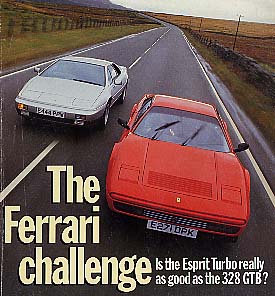
Lotus' Esprit Turbo faces its toughest test yet -
two days and 600 miles of nose to tail charging with
Ferrari's ever-stupendous 328.
Does Britain now boast a mid-engined supercar
to match the pride of Italy?
It wasn't until I pulled into the lay-by that I notice how hard it was raining. The bright red Ferrari sat there contentedly, raindrops sizzling on the engine cover, its squat Goodyear tyres steaming. It was a good half a minute before the Lotus arrived. Our road test last week of the new Lotus Esprit Turbo had begged the comparison. Quicker, faster and better mannered than ever before, the new Esprit is a fine sports car.
With stunning looks and a sense of integrity it has never had before, the Lotus can at last hold its head high in Porsche and Ferrari company. In a straight line the Esprit can ease away from a Ferrari 328GTB, but how would it measure up on the road?
That last 30-mile dash had brought the strengths and weaknesses of the two cars into sharp focus. We had driven 600 miles, along motorways and through congested town centres as well as winding country lanes and sweeping Welsh mountain roads. After bone-dry tarmac and a couple of brief showers, the second day had brought dark skies and torrential rain. We had our winner.
On paper the two cars have remarkably similar performance. Both are capable of over 150mph — the Lotus reaching 150mph and the Ferrari 153mph on Millbrook's two-mile banked track. The Esprit Turbo sprints to 60mph in 5.4seconds, covers the standing quarter mile in 13.7secs at 103mph and the kilometre in 25secs dead at 129mph. The Ferrari's more rearward weight bias gives better grip off the line, but above 50mph it lags slightly behind the Esprit with 0-60 of 5.5secs, a standing quarter of 14.1secs at 99mph and a kilometre time of 25.5secs at 128mph.
Mid-engined, rear-wheel-drive two-seaters of similarly explosive performance they may be, but the 328GTB and Esprit take diametrically opposite power routes — Lotus chooses the turbocharger while Ferrari traditionally sticks with a relatively large capacity, normally aspirated engine.
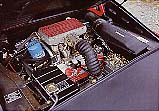
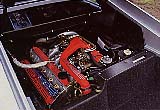
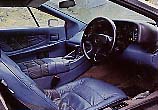
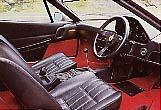
Both all-alloy engines feature double overhead camshafts opening four valves per cylinder but the Esprit's 2174cc four-cylinder unit sits longways behind the cabin and drives through a Renault GTA five-speed transaxle. A beautifully-engineered 3185cc V8 sits across the 328's chassis, with the constant-mesh five-speed gearbox below and behind, in unit with the block.
The Lotus engine runs a compression ratio of 8.0:1 and a boost pressure of 9.5psi — quite high for a non-intercooled motor — giving 215bhp at 6000rpm and 2201b ft of torque at 4250rpm. Ferrari's normally-aspirated V8 runs at 9.8:1 and delivers 270bhp at 7000rpm and 2231b ft at 5500rpm. With that sort of power, both cars drive through limited slip differentials.
With no engine to get in the way at the front, the Esprit and 328 both sit on double wishbone front suspension. Ferrari sticks with the same system for the rear, while the Lotus has trailing arms with upper and lower transverse links.
Both cars wear Goodyear Eagle tyres (NCT on the Lotus) on alloy wheels with 7ins-wide rims at the front and 8ins at the rear. The Lotus steers via 195/60VR15 rubber and drives through 235/60VR15s — l6ins diameter 2O5/55s and 225/60s are fitted to the Ferrari. Neither car needs or gets power assistance for its rack and pinion steering. After a dozen years the sharp Giugiaro lines of the original Esprit have been softened by Lotus's own design team. Little different in overall dimensions from the original, the car now looks smoother, more flowing and sensuous in its appeal.
Five inches narrower, three inches shorter, half an inch lower and 80lb lighter than the Lotus, the 328GTB remains faithful to Pininfarina's original design. Both cars appeared in 1975 but, while the Esprit's shape needed bringing up to date, the classic Ferrari remains one of the most beautiful on the road.
Climb into either cabin and the interior reflects the exterior treatment. The Lotus is new: large angular panels, a high centre tunnel and the padded two-tone leather trim giving it the look of a show car. In the Ferrari all is classically elegant: more spacious with simple, neat but comprehensive controls and instruments, and beautifully-finished black leather.
After a couple of days, It was clear
that these are two exceptional cars.
Even in the wet, it Is possible to use a great deal of their performance
With its wide, deep centre tunnel you sit deep down in the Lotus. There's still enough legroom and the seats lack side, and lumbar support, but headroom is adequate for anyone under 6ft 3ins. A large roof panel can be tilted up at the rear or removed — a glass version is available as an option.
A huge instrument panel dominates the top of the Esprit's dash housing all the black-on-white VDO instruments. Speedometer and rev counter are surrounded by voltmeter, coolant temperature, oil pressure, fuel gauge, turbo boost and a small digital clock, but the rim of the fixed steering wheel obscures the top of the rev counter and the fuel gauge.
With better top speed and acceleratIon, the new Esprit Is solid Improvement on Its predecessor.
A much lower, narrower centre tunnel in the 328 gives the impression of more space inside — you sit on, not down in, this car. The black leather seats are thinly padded but well shaped with plenty of support - ultimately they are very comfortable. There is sufficient legroom despite a wheelbase which is 4ins shorter than the Lotus, but taller drivers will need to recline the backrest to obtain enough headroom.
The main instrument panel is much smaller and neater, with extra gauges at the top of the centre console and an oil temperature gauge in place of the Espritôs voltmeter. Orange-on-black Veglia dials are fine during the day but can be difficult to read at night.
Finding somewhere to store cassettes, sunglasses, maps and so on is is a problem in the Lotus. There is a glove box but it's a long stretch away from the driver and the lid doesn't stay open on its own, whereas reaching the pocket on the firewall behind the seats is a recipe for a dislocated shoulder.
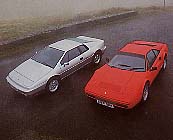
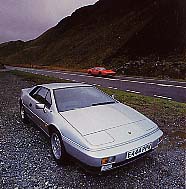
In the Ferrari you can choose between a fold-out pocket in each door, elasticated pocket on the passenger side of the footwell centre rib and the back of each seat, a tray to the right of the steering column and another between the seats plus a locking box with a cassette holder at the back of the centre tunnel. Electric windows and mirrors are common to both cars, but the Ferrari has the benefit of central locking. The cost of a stereo in either car is up to you.
Turn the key, hot or cold, and the 328's fuel injected V8 fires up instantly and settles down to a smooth, steady idle. On the Esprit you need full manual choke from cold and you need full manual choke from cold and even then the two Dellorto twin-choke carbs take a while to stoke the engine into life. Despite an electric engine purge pump, hot starting in the Lotus is still leisurely. What's more, the idle is erratic. It varies between 800 and 1400rpm depending on engine temperature. The Ferrari's idle, too, became erratic towards the end of the test.
Through the traffic of Evesham and Worcester both cars proved more manageable than expected. Light, progressive clutches and engines that are perfectly at ease ambling along at tickover help. The Lotus suffers from heavier low-speed steering than the Ferrari, and engine response at the very bottom of its operating band is sluggish.
The Ferrari's lower nose gives better forward visibility. To the rear, the Esprit's glass panel between the buttresses causes distortion — with only one sheet of glass instead of three to look through, the Ferrari fares better. Rear three-quarter vision in the 328 is also significantly better than the Lotus, which still isn't bad for a mid-engined car.
The all-alloy engine features double overhead camshafts openIng four valves per cylinder
Both cars have a surprisingly good ride even at low speed. The Lotus is supple, the Ferrari firmer without being harsh. Up the pace on the motorway and the GTB smoothes out beautifully, but you are conscious of considerably more road noise than in the Lotus. However, the Lotus generates wind noise and, although the Esprit engine is quieter, the Ferrari's gear whine and barely disguised V8 snarl are music to the ears. Both cars are stable, at speed, the Lotus rock steady, the Ferrari more alive and communicative but no less accurate.
The series of hairpins leading us down from the Malvern Hills were thankfully dry, and we were able to extend the two cars more. Both have fine brakes — ventilated discs all round on the GTB, and at the front of the Esprit — which has solid at the rear end. Downhill there was no trace of premature front wheel lock-up, although the pedal response on the Esprit was over-servoed and not as progressive as the 328.
Once mastered, the gearchange on the Ferrari is quick and positive. It is rather notchy from cold but, once the oil has warmed, the long chromed lever can be snicked through the metal gate on the centre tunnel with a satisfying clack as the lever slots home. With a dog-leg first gear, the box cries out to be used hard - when taking things more gently, though, the gearbox is sometimes reluctant to co-operate.
Like the Lotus, the Ferrari's pedals are close set for easy heel and toe gearchanging. Offset to the left to clear the wheelarch, the gearknob gets uncomfortably close to your knee in fourth when your left foot is on the footrest.
Lotus is tied to external suppliers for its transmissions - the current choice of a Renault GTA gearbox brings a rubbery and rather imprecise action. Although quick changes can be made, courtesy of the light and positive clutch, up or down into second is very hit or miss.
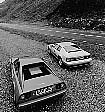
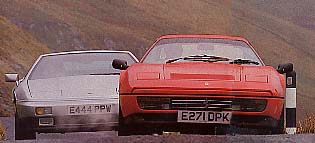
Hard on the brakes, down through the box and turn in to a hairpin. . . and the different character of the cars begins to emerge. Drive at maybe nine-tenths and the Esprit responds well, a twist of the sculpted 14ins wheel is enough to set the car up quickly and accurately for the corner. But as you start to drive harder, the Lotus demands more exertion, and its responses begin to dull. Now it starts to understeer briefly and, once in the corner, the steering loads up to the point where it demands real effort.
Get the power on to kill the understeer and, as the Esprit comes on boost, it needs quick reactions from the driver - sometimes quicker than the steering can deliver. Lotus has done very well to smooth the Espritôs response as much as it has but, on the limit, even slight turbo lag is unwelcome. Leave the Lotus in a higher gear and the engine won't pull - a look at the in-gear acceleration figures shows the 328's clear superiority at the lower end of the rev range in every ratio.
It's the steering response of the 328 more than anything else that lifts it on to another plane. Always lighter than the Lotus, the feel and communication through that gorgeous Momo steering wheel are without parallel.
At 3.25 turns lock to lock compared with the Lotus's 2.9, the gearing is lower — indeed you are conscious of dialling-in more lock as you flick the GTB through a series of tight bends, but the precision and immediacy of its turn-in more than compensate. There is some bump-steer and tramlining under braking but, although you can feel the front wheels twitching through the steering wheel, the car itself doesn't deviate from the chosen line.
The tremendous spread of power delivered by that wonderful V8 makes steering the GTB on the throttle child's play. From 2000 right round to the 7800rpm limit, there is instant torque available in response to the slightest movement of the throttle. The Lotus, in contrast, is at its best between 3000 and 7000rpm and there is always a hint of lag.
Floor the GTB at the apex and you can feel the rear tyres drift to tighten the line. Even in the wet you would be hard pushed to lose the back end on the throttle alone. In the dry, with that engine and steering, you feel you can safely do whatever you want with the car.
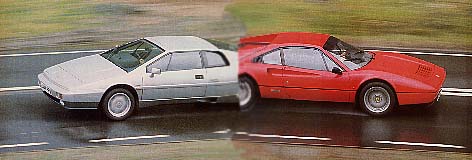
Driven hard and determinedly, the Lotus could still hold its own in the dry. The Ferrari was easier to drive and felt more trustworthy, but the Lotus's straight line advantage keep it in touch. Over bumpy surfaces the GTB had more of an advantage, while high-speed sweeping curves demonstrated its terrific damping control and poise. The Esprit's superior low-speed ride, on the other hand, was reflected in altogether less taut behaviour.
In the wet the next day, even desperate tactics couldn't quite keep the Lotus in touch. Following the 328 into a corner, the Esprit would understeer markedly and attempting to balance it on the throttle was a recipe for a snap into oversteer as the engine came on boost. The Ferrari still turned in smoothly and precisely, had more ultimate grip once in the corner and could be powered out in a gear higher than the Lotus. All this with the rear never threatening to break away.
Engine Is at Its best between 3000 and 7000rpm, though there Is always a hint of lag. Inside, the top of the dash Is dominated by a huge Instrument panel. Headroom Is adequate but seats lack support.
On faster sweepers, the difference was more pronounced. With the Lotus twitching and slithering in and out of a four wheel drift, the Ferrari would be edging away slowly but surely, never deviating from its line and feeling totally secure at all times.
With its complex, but effective heating and ventilation system, the Ferrari coped better with demisting duties in the wet. Two sets of rocker switches and LED bar displays, and no fewer than four separate fan controls took some getting used to, but made the Lotus's simple two dial system appear weak and inadequate.
With ambient temperatures creeping up, the GTB needed the optional air conditioning to keep the cabin temperature under control (the Lotus has almost non-existent fresh air ventilation but at least you can compensate by taking the roof panel off).
After two days it was clear that these were two exceptional high performance cars. Even in the wet, it was possible to use a great deal of their power, more than we had thought possible from this type of mid-engined, no compromise sports car. Both have tremendous performance plus good handling and roadholding, with surprising ride comfort and practicality.
There are cars that would have covered the ground as quickly, especially in the wet - like a powerful four-wheel-drive model. When it could comes down to it, the Audi quattro or Lancia Integrale could easily have kept up on the twisty stuff, but that's missing the point. The 328 GTB and the Esprit Turbo are sports cars, and are bought for that reason.
The new Esprit Turbo is good, very good but at the end of the day the Ferrari is a clear winner. The limits of the 328 GTB are just that little bit further in every direction than the Lotus and, thanks to that wonderful steering and proper engine, it's much easier to explore them. A true classic, it's beautifully-built, exceptionally well-sorted and wonderfully rewarding to drive.
At under £30,000 the Esprit Turbo is real value. But the 328 GTB is worth every penny of the extra £14,000.
HOW THEY COMPARE
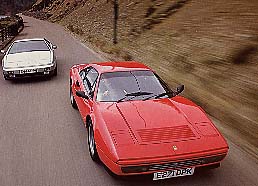
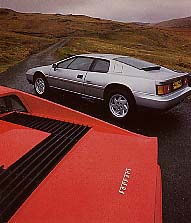
| DRIVETRAIN | FERRARI |
LOTUS |
| Cylinders | 8,90 deg V | 4 inline |
| Capacity | 3185cc | 2174cc |
| Bore/stroke (mm) | 83/73.6 | 95.3176.2 |
| Valve gear | 2ohc per bank 32 valves | 2ohc 16 valves |
| Compression ratio | 9.8:1 | 8.0:1 |
| Induction | Bosch K-Jetronic | Twin Deliono DHLA,Garrett T3 |
| Power/rpm | 270bhp/7000 | 2l5bhp/6000 |
| Torque/rpm | 223lb ft/5500 | 220lb ft/4250 |
| Mph/100rpm top | 20.9 | 23.7 |
| Final drive | 3.71:1 | 3.88:1 |
|
DIMENSIONS |
||
| Length (Ins) | 167.5 | 170.5 |
| WIdth (Ins) | 68.1 | 73.2 |
| Height (Ins) | 444 | 44.8 |
| wheelbase (Ins) | 92.5 | 96.8 |
| Track f/r (Ins) | 58.4/57.7 | 60.0/61.2 |
| Kerb weight (Lb) | 2972 | 3052 |
| Distribution f/r (%) | 44/54 | 51/49 |
| PRICES | ||
| Total in GB | £44,196 | £29,950 |
| FUEL CONSUMPTION | ||
| Overall mpg | 16.2 | 16.8 |
| Road test mpg | 18.3 | 19.6 |
| Fuel tank (gals) | 16.3 | 18.0 |
| PERFORMANCE | ||
| Max mph/rpm | 153/7300 | 150/6350 |
| 0-30mph (sec.) | 2.1 | 2.3 |
| 0-60 | 5.5 | 5.4 |
| 0-100 | 14.2 | 13.3 |
| 0-130 | 26.7 | 26.0 |
| Standing 1/4 mile | 14.1 (99mph) | 13.7(103mph) |
| standing km | 25.5 (128mph) | 25.0(129mph) |
In each gear
| mph |
Top
|
4th
|
3rd
|
2nd
|
| FERRARI | ||||
| 10-30 |
-
|
5.2
|
3.7
|
2.6
|
| 20-40 |
7.4
|
4.9
|
3.3
|
2.4
|
| 30-50 |
6.9
|
4.6
|
3.2
|
2.2
|
| 40-60 |
6.7
|
4.5
|
3.1
|
2.4
|
| 50-70 |
6.8
|
4.4
|
3.0
|
-
|
| 60-80 |
6.8
|
4.4
|
3.3
|
-
|
| 70-90 |
6.9
|
4.5
|
-
|
-
|
| 80-100 |
7.4
|
4.7
|
-
|
-
|
| 90-110 |
7.9
|
5.3
|
-
|
-
|
| 100-120 |
8.3
|
6.9
|
-
|
-
|
| 110-130 |
9.5
|
-
|
-
|
-
|
| LOTUS | ||||
| 10-30 |
-
|
-
|
6.2
|
3.6
|
| 20-40 |
12.6
|
7.6
|
4.4
|
2.4
|
| 30-50 |
9.6
|
5.5
|
3.3
|
2.0
|
| 40-60 |
7.2
|
4.6
|
3.0
|
2.2
|
| 50-70 |
6.3
|
4.3
|
2.9
|
-
|
| 60-80 |
6.3
|
4.2
|
3.1
|
-
|
| 70-90 |
6.3
|
4.3
|
3.6
|
-
|
| 80-100 |
6.3
|
4.6
|
-
|
-
|
| 90-110 |
6.9
|
5.2
|
-
|
-
|
| 100-120 |
7.7
|
6.5
|
-
|
-
|
| 110-130 |
9.3
|
-
|
-
|
-
|
|
|